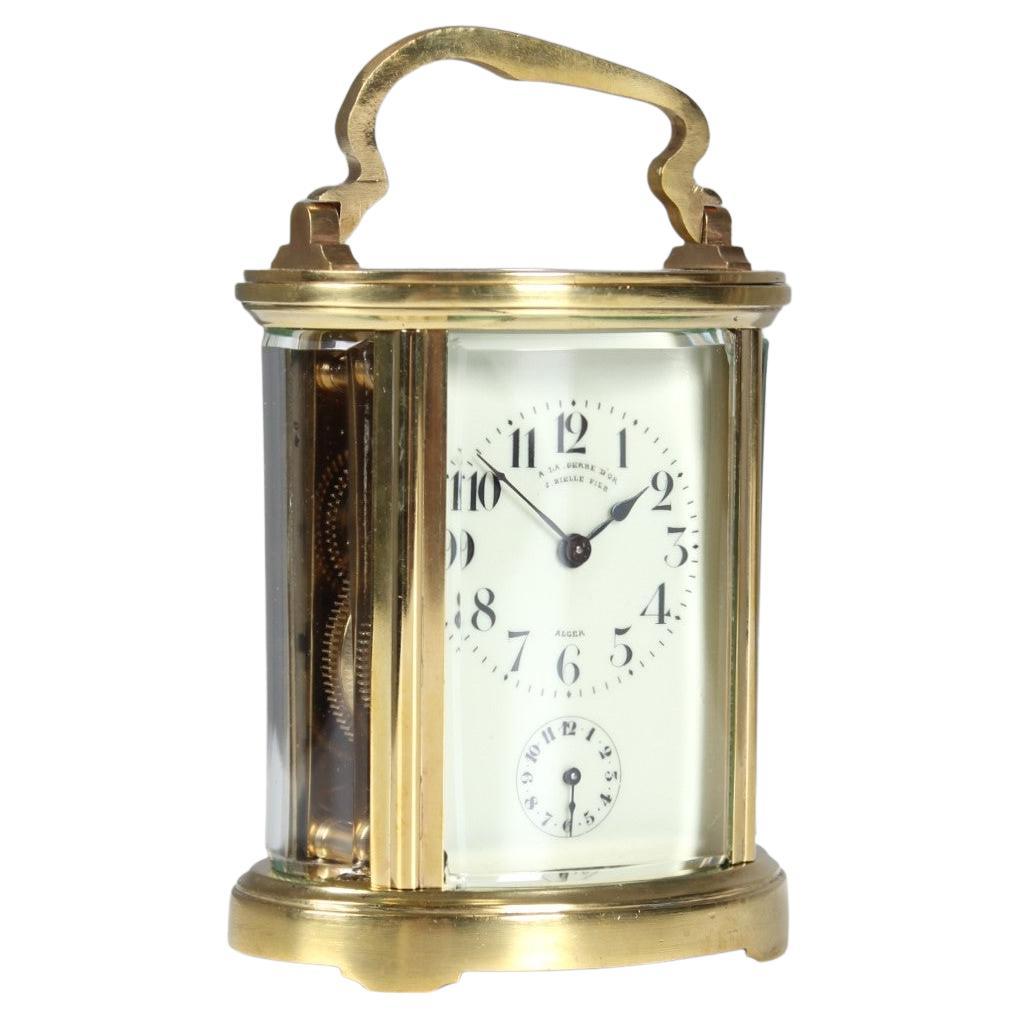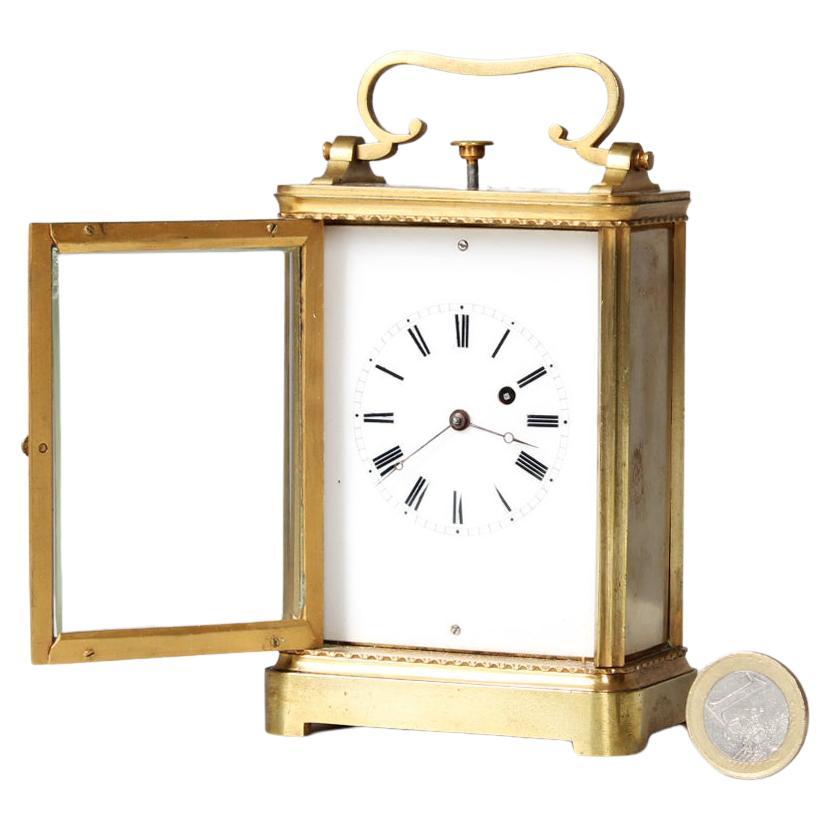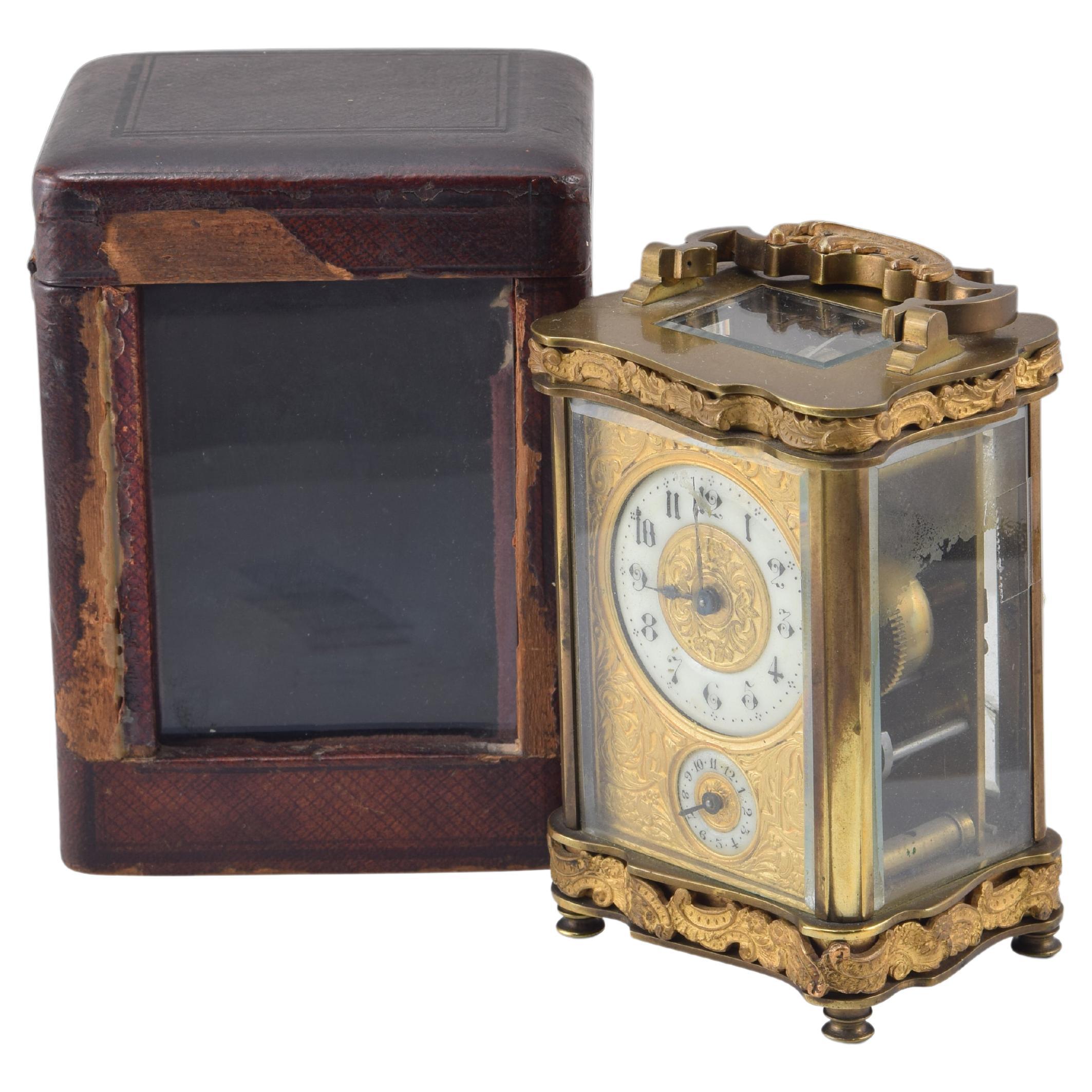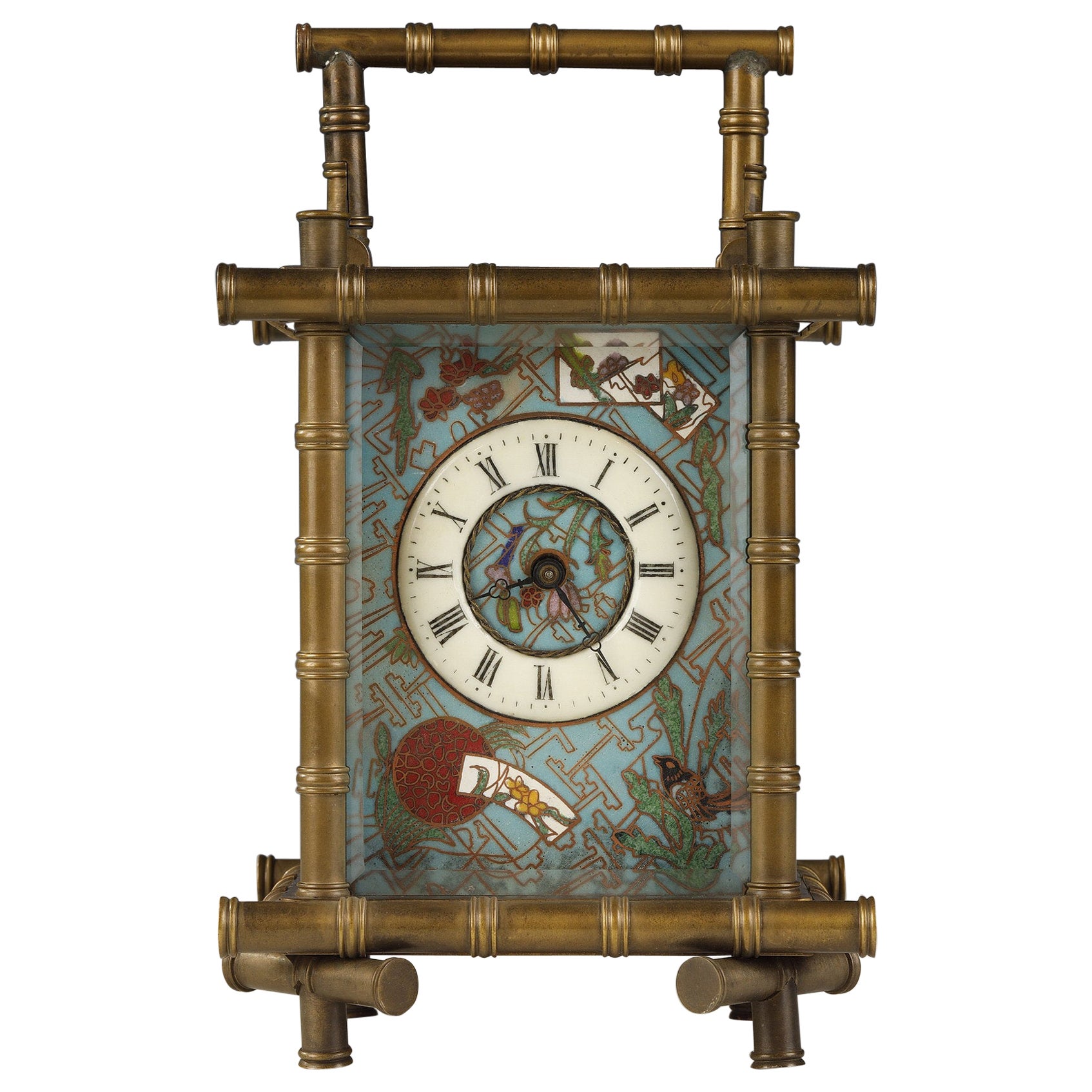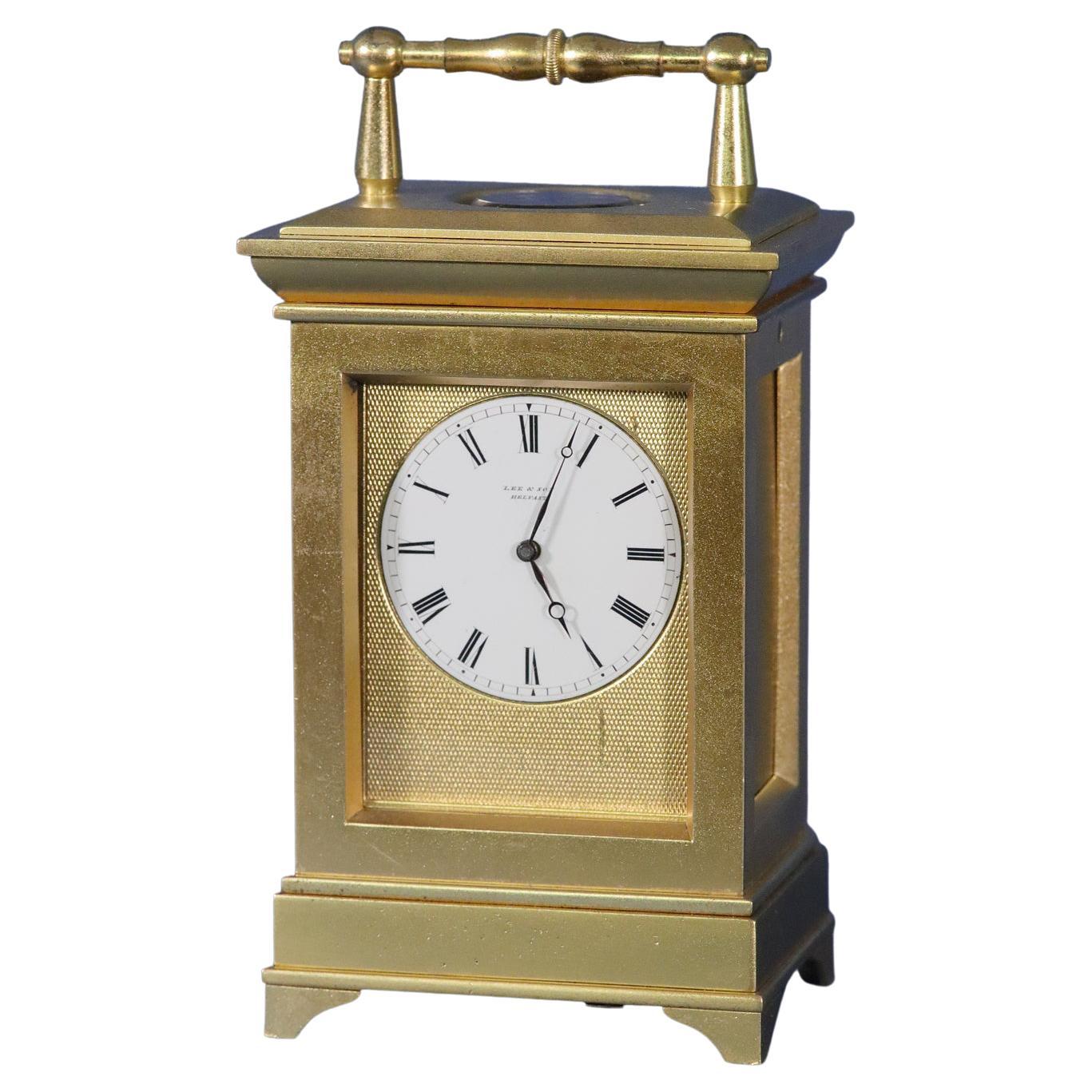Items Similar to Late 19th Century Carriage Clock, Travel Clock, Pendulette de Voyage, Paris 1890
Want more images or videos?
Request additional images or videos from the seller
1 of 11
Late 19th Century Carriage Clock, Travel Clock, Pendulette de Voyage, Paris 1890
About the Item
Dimensions: H x W x D: 16 x 9 x 7 cm
The height is measured with handle. Without handle it is 12 cm in height.
Beautiful antique carriage clock or officer's clock.
Rare oval shape.
Alarm time is set by the lower dial. To wake up the clock strikes a bell mounted on the underside.
Dial with old dealer signature: LUTZ 6 Rue de Lyon PARIS
Condition: Cleaned condition of movement and case. The clock runs perfectly and reliably.
- Dimensions:Height: 6.3 in (16 cm)Width: 3.55 in (9 cm)Depth: 2.76 in (7 cm)
- Materials and Techniques:
- Place of Origin:
- Period:
- Date of Manufacture:1890-1900
- Condition:Refinished. Wear consistent with age and use. Cleaned condition of movement and case. The clock runs perfectly and reliably.
- Seller Location:Greven, DE
- Reference Number:1stDibs: LU5419232176132
About the Seller
5.0
Platinum Seller
These expertly vetted sellers are 1stDibs' most experienced sellers and are rated highest by our customers.
Established in 2014
1stDibs seller since 2020
114 sales on 1stDibs
Typical response time: <1 hour
- ShippingRetrieving quote...Ships From: Münster, Germany
- Return PolicyA return for this item may be initiated within 14 days of delivery.
More From This SellerView All
- French Late 19th Century Carriage Clock, Pendulette De VoyageLocated in Greven, DEAntique travelling clock with alarm function from the late 19th century. Measures: H x W x D: 12 (with handle 15) x 9.5 x 7 cm. Oval brass cas...Category
Antique Late 19th Century Carriage Clocks and Travel Clocks
MaterialsBrass
- 19th Century Travel Clock with Repetition, Carriage Clock, Pendule de VoyageLocated in Greven, DETravel clock with repetition France Brass 19th century Dimensions: H x W x D: 11 x 7,5 x 4,5 cm Description: Small travel clock, so-call...Category
Antique 19th Century French Carriage Clocks and Travel Clocks
MaterialsBrass
- French Capucine Carriage Clock, Pendule de Voyage with Alarm, Circa 1800Located in Greven, DEAntique Capucine travel clock France Brass, enamel circa 1800 Dimensions: H x W x D: 29 x 12 x 8 cm Description: Antique travelling clock...Category
Antique Early 19th Century French Table Clocks and Desk Clocks
MaterialsBrass
- Early 19th Century Mantel Clock, Firegilt Bronze, Paris circa 1810Located in Greven, DEVery rare "Au Bon Sauvage" mantel clock France Fire-gilt and patinated bronze Empire around 1810 Dimensions: H x W x D: 34 x 41 x 13 cm Description: Extremely rare French bronze m...Category
Antique Early 19th Century French Empire Mantel Clocks
MaterialsBronze
- 19th Century Regulator by Tarault Jeune, Precision Portal Clock, Paris, c. 1825Located in Greven, DETable regulator - Precision portal clock Paris mahogany, bronze, enamel around 1825 Dimensions: H x W x D: 49 x 28 x 15 cm Description: Antique precision portal clock from the 182...Category
Antique 1820s French Restauration Table Clocks and Desk Clocks
MaterialsBronze, Enamel
- Early 19th Century Ormolu Mantel Clock, Atala freeing Chactas, Paris, circa 1810Located in Greven, DEMantel Clock "Atala and Chactas" Paris Bronze (fire-gilt and patinated), enamel Empire around 1810 Dimensions: H x W x D: 40 x 32 x 11 cm Description: Very rare and extremely high quality French mantel clock, so-called Pendule Au Bon Sauvage. Depicted are scenes from the love story "Atala or the love of two savages in the desert" written by Francois René Vicomte de Chateaubriand in 1801. At the beginning of the 19th century, this was probably the most famous love story in Europe, but today it has been forgotten. The story, set in present-day Louisiana (USA), is roughly rewritten about the forbidden love between Chactas, a young Indian, and Atala, the beautiful daughter of a Spaniard. Chactas is captured in a battle between two Indian tribes, chained to a palm tree and is to be sacrificed. Atala wants to save his life and convert him to Christianity. She unties him from the palm tree at night and they flee together into the wilderness of North America. Their love for each other grows stronger and stronger and they have prospects for a future together. The story takes a tragic turn when Atala, who must remain a virgin due to a vow made by her mother, can no longer withstand the conflict of her feelings and commits suicide. The main group of characters thus shows Chacta's liberation through Atala. Atala is leaning against a pile of logs. The animal fur thrown over the logs and the weapons leaning against the stack on the right give the impression of a night camp. The bronze is of rarely beautiful quality, finely chiselled and makes the scene appear very lively. The contrast of fire-gilded and patinated bronze adds tension to the composition. In the base we see the Entombment as the end of the tragic love story. This bronze work is also very detailed, the interplay of bright and matt gilding makes the flat relief appear much deeper than it is. The depiction of the mantel clock presented here shows that the exotic was only known from stories and that the bronzier had his own ideas about the appearance of this distant world. The Indian, for example, has very European facial features and his skin was not black in reality, of course. The palm tree was also certainly not found in the North American wilderness. The heart of the clock is a French pendulum movement, integrated into the wooden pile, with an eight-day power reserve and a lock plate striking a bell on the half and full hour. The pendulum is suspended on a thread, typical of the period. The classically shaped hands, so-called Breguet hands, are also typical of the time. The enamelled dial has black Roman hour numerals, Arabic quarter hours and bears the signature: Le Roy hr. de Madame A PARIS. Interesting facts: The period from 1795 to about 1815 saw the creation of probably the most spectacular group of bronzes: The "Au bon Sauvage" pendulums - depictions of the "Noble Savage". Today's viewers react to these objects with both fascination and irritation. Enthusiastic on the one hand about the obvious quality of the detailed bronzes and the allure of the exotic, on the other hand distanced and cautious because of the possible discrimination that is suspected behind them. The ambivalence of this feeling motivates the search for the conditions of origin of these pendulums. Europeans found their new ideal of the natural man primarily in fictional and realistic travelogues about the Indians of North America...Category
Antique Early 19th Century French Empire Mantel Clocks
MaterialsOrmolu
You May Also Like
- Carriage clock with case. 19th centuryLocated in Madrid, ESTravel clock with case. Metal, glass, leather, etc. XIX century. Case with lid at the top and front with a transparent glass sheet, upholstered on the inside, containing a travel cl...Category
Antique 19th Century European Neoclassical Revival Carriage Clocks and T...
MaterialsMetal, Other
- Mid 19th-Century Gilt-Bronze Carriage ClockLocated in Greenlawn, NYLee & Son, Belfast – Retailer The very heavy gilt-bronze case has a bollard handle, a glass viewing panel above, is stamped 1522 and has a pinned back door with the release on th...Category
Antique Mid-19th Century English Victorian Carriage Clocks and Travel Cl...
MaterialsOrmolu
- Aesthetic Movement Carriage Clock, France, 19th CenturyLocated in PARIS, FRFine aesthetic movement clock in cloisonné enamel and gilded bronze, decorated with polychromed birds and flowers, and geometric gilded ornaments on a ...Category
Antique Late 19th Century French Aesthetic Movement Table Clocks and Des...
MaterialsBronze, Enamel
- 19th Century Victorian English Carriage Travel Clock in Leather Case with KeyLocated in Hamilton, OntarioAntique Victorian English eight day brass carriage travel clock having a quality white enamel dial with Roman numerals, original hands and eight day movement in a brass and beveled g...Category
Antique Mid-19th Century English Victorian Carriage Clocks and Travel Cl...
MaterialsBrass
- 19th Century Carriage Clock by Waterbury Clock Co., U.S.ABy Waterbury Clock Co.Located in Hamilton, Ontario19th century Waterbury carriage clock. It has been recently cleaned and serviced and works perfectly.Category
Antique 19th Century American Carriage Clocks and Travel Clocks
- French Travel Clock by Aiguilles, late 19th / early 20th centuryLocated in Greding, DESmall brass travel clock with curved handle and small profiled base. Signed Aiguilles on the movement.Category
Antique Late 19th Century French Late Victorian Carriage Clocks and Trav...
MaterialsBrass
Recently Viewed
View AllMore Ways To Browse
Cartier Or Boucheron Travel Or Desk Clock
Travel Office
Traveling Case
Paris France Dealer
Travel Rare
Antique Furniture Travel
French Travelling Case
Old Paris Set
Late 19th Century French Clocks
Antique Travelling Set
Antique Travel Glasses
Old Clocks
Glass Bell 19th Century
Used Old Clocks
Antique Clock 1890
Alarm Clocks
Alarm Clock
Alarm Clock Used
